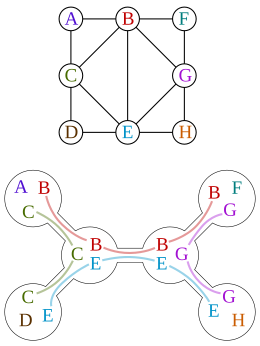
In graph theory, a tree decomposition is a mapping of a graph into a tree that can be used to define the treewidth of the graph and speed up solving certain computational problems on the graph.
Tree decompositions are also called junction trees, clique trees, or join trees. They play an important role in problems like probabilistic inference, constraint satisfaction, query optimization,[1] and matrix decomposition.
The concept of tree decomposition was originally introduced by Rudolf Halin (1976). Later it was rediscovered by Neil Robertson and Paul Seymour (1984) and has since been studied by many other authors.[2]
- ^ Gottlob et al. (2012).
- ^ Diestel (2005) pp.354–355